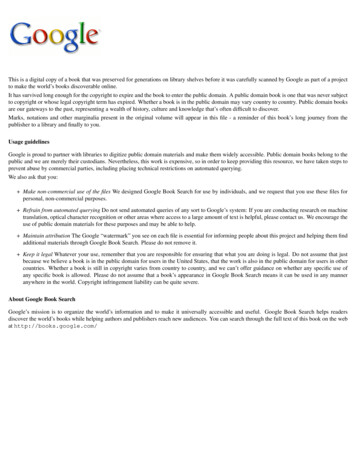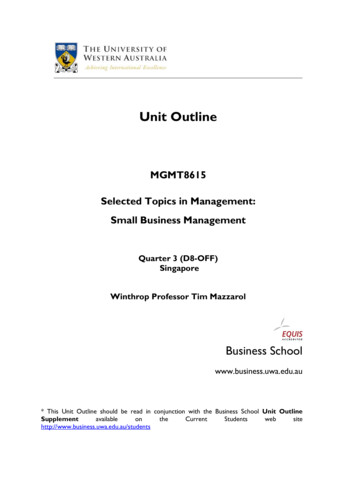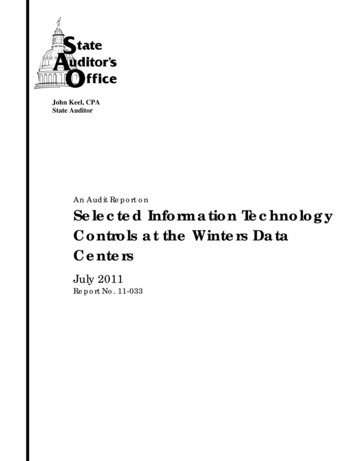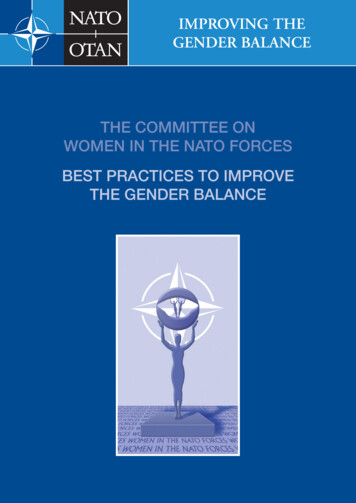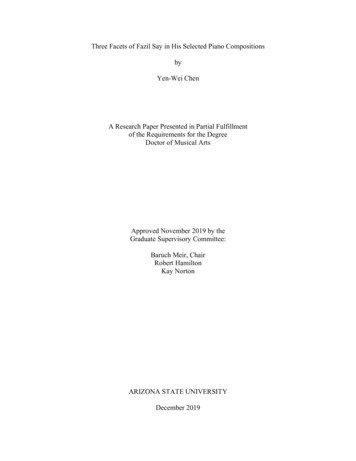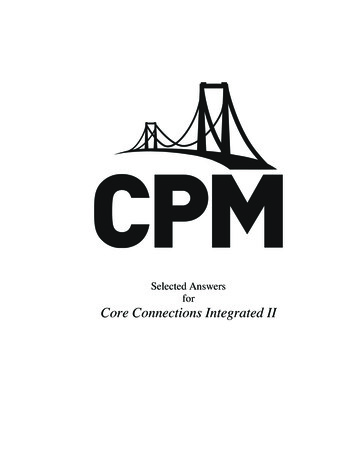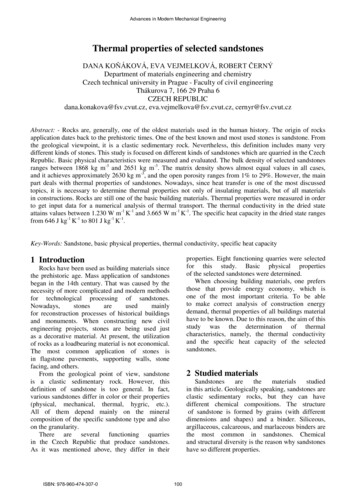
Transcription
Advances in Modern Mechanical EngineeringThermal properties of selected sandstonesDANA KOŇÁKOVÁ, EVA VEJMELKOVÁ, ROBERT ČERNÝDepartment of materials engineering and chemistryCzech technical university in Prague - Faculty of civil engineeringThákurova 7, 166 29 Praha 6CZECH REPUBLICdana.konakova@fsv.cvut.cz, eva.vejmelkova@fsv.cvut.cz, cernyr@fsv.cvut.czAbstract: - Rocks are, generally, one of the oldest materials used in the human history. The origin of rocksapplication dates back to the prehistoric times. One of the best known and most used stones is sandstone. Fromthe geological viewpoint, it is a clastic sedimentary rock. Nevertheless, this definition includes many verydifferent kinds of stones. This study is focused on different kinds of sandstones which are quarried in the CzechRepublic. Basic physical characteristics were measured and evaluated. The bulk density of selected sandstonesranges between 1868 kg m-3 and 2651 kg m-3. The matrix density shows almost equal values in all cases,and it achieves approximately 2630 kg m-3, and the open porosity ranges from 1% to 29%. However, the mainpart deals with thermal properties of sandstones. Nowadays, since heat transfer is one of the most discussedtopics, it is necessary to determine thermal properties not only of insulating materials, but of all materialsin constructions. Rocks are still one of the basic building materials. Thermal properties were measured in orderto get input data for a numerical analysis of thermal transport. The thermal conductivity in the dried stateattains values between 1.230 W m-1 K-1 and 3.665 W m-1 K-1. The specific heat capacity in the dried state rangesfrom 646 J kg-1 K-1 to 801 J kg-1 K-1.Key-Words: Sandstone, basic physical properties, thermal conductivity, specific heat capacityproperties. Eight functioning quarries were selectedfor this study. Basic physical propertiesof the selected sandstones were determined.When choosing building materials, one prefersthose that provide energy economy, which isone of the most important criteria. To be ableto make correct analysis of construction energydemand, thermal properties of all buildings materialhave to be known. Due to this reason, the aim of thisstudy was the determination of thermalcharacteristics, namely, the thermal conductivityand the specific heat capacity of the selectedsandstones.1 IntroductionRocks have been used as building materials sincethe prehistoric age. Mass application of sandstonesbegan in the 14th century. That was caused by thenecessity of more complicated and modern methodsfor technological processing of sandstones.Nowadays,stonesareusedmainlyfor reconstruction processes of historical buildingsand monuments. When constructing new civilengineering projects, stones are being used justas a decorative material. At present, the utilizationof rocks as a loadbearing material is not economical.The most common application of stones isin flagstone pavements, supporting walls, stonefacing, and others.From the geological point of view, sandstoneis a clastic sedimentary rock. However, thisdefinition of sandstone is too general. In fact,various sandstones differ in color or their properties(physical, mechanical, thermal, hygric, etc.).All of them depend mainly on the mineralcomposition of the specific sandstone type and alsoon the granularity.There are several functioning quarriesin the Czech Republic that produce sandstones.As it was mentioned above, they differ in theirISBN: 978-960-474-307-02 Studied materialsSandstonesarethematerialsstudiedin this article. Geologically speaking, sandstones areclastic sedimentary rocks, but they can havedifferent chemical compositions. The structureof sandstone is formed by grains (with differentdimensions and shapes) and a binder. Siliceous,argillaceous, calcareous, and marlaceous binders arethe most common in sandstones. Chemicaland structural diversity is the reason why sandstoneshave so different properties.100
Advances in Modern Mechanical Engineeringthe saturated one. Samples were put intoa desiccator with boiled distilled water and air wasevacuatedwithvacuumpump(Fig.1).After removing samples from desiccator, their massin saturated state was measured (mw). Finally,the value necessary for calculating the basicphysical properties is the mass of saturated samplesunder the water, so called the Archimedes mass(ma). The basic physical characteristics weredetermined from the equationsThe studied materials were sandstones quarriedin the Czech Republic. The number of quarries ischanging every year, depending on the economicsituationandpossibilitiesofquarrying.For this study eight functioning quarries werechosen. In table 1 we give basic information on theselected sandstones.Table 1: Studied sandstones [1]attributecolourquarrygrainsizeS1quartzose /feldspathichoarBožanovcoarseS2quartzose / greyish bluefeldspathic ochre edgesBzováfine,,S3 quartzosegrey white Podhorníup to yellow ÚjezdfineS4 quartzosegrey whiteup to yellowKocbeřfineS5 quartzosekelly green,yellow-greenZámělmediummicaceous greenish grey- greenup to tealŘekafineS6S7 feldspathichazelÚpice(Lány)mediumS8 quartzoseGrey whiteMšenélázněfine(2),(3).3 Experimental methods(4)Fig. 1: Vacuum pump with desiccatorAs was mentioned in the introduction,the measured properties belong to two categories.Measurements of basic physical and thermalproperties were performed by the methodsthat we shall now describe.3.2 Thermal propertiesThesecondgroupofcharacteristicsis the thermal properties. Using the apparatusISOMET 2104 [3], the thermal conductivity (λ)and the volumetric heat capacity (cρ) weremeasured. This commercial device appliesa dynamic measurement method so that the timeof measurement reduces to dozens of minutes.The measurement process is based on the analysisof a temperature response of the analyzed materialto heat flow impulses. The heat flow is inducedin a resistor of probe by a distributed electric power.The temperature is recorded and evaluated fromthe polynomial regression.ISOMET 2104 is verified by special etalons withknownvaluesofthermalconductivity.This verification of measuring ability had beenperformed before the actual measurement started.3.1 Basic physical propertiesFirst, the basic physical characteristics weremeasured. For the determination of the bulk density(ρ), the matrix density (ρmat), and the open porosity(ψ0) the vacuum water saturation method [2] wasused. This method is based on weighing samplesin different moisture states. Five samples of eachtypeofsandstonewithdimensionsof 50 50 50 mm were used for thismeasurement. The first measured moisture state wasthe dried one (md). To remove physically boundedwater, samples were put in a drying box keptat a temperature of 105 C. The second state wasISBN: 978-960-474-307-0(1)101
Advances in Modern Mechanical EngineeringIn the case of the thermal conductivity the errorof measurement was, in all cases, less than 3 %.However in the user manual for thisdevice [3] the accuracy of the thermal conductivityis5%ofreading 0.001W m-1 K-1.In the case of the volumetric heat capacity theaccuracy is 15% of reading 1 J m-3 K-1.Measurements by ISOMET 2104 are performedusing special probes. These probes are of two kinds– needle probes or surface probes. In this studysurface probes were used. According to the chosenprobes, the height of samples had to be more than15mm and their surface had to be circularwith a minimal diameter less than 60 mm.Both thermal properties were determinedin dependence on the moisture content. Threesamples with dimensions of 70 70 70 mm wereprepared. The first measurement of the thermalconductivity and volumetric heat capacitywas performed under laboratory conditions.Then the samples were put into a drying boxwith a temperature of 105 C to remove physicallybounded water. Thermal properties were measuredin the dried state. For another few weeks sandstoneswere kept in water to achieve the fully saturatedstate (without using an external pressure).The measurements using ISOMET 2104 wereperformed again. Then the samples where leftin the open air so they could dry out naturally.During the drying process thermal propertiesof sandstones were determined in a specificmoisture state. Before measuring by ISOMET 2104,the samples were, for a certain time, kept in a plasticbag due to stabilization of the moisture field.The moisture content needed to be calculatedas well. To this end, we used the well-knownequations,(6).(7)4 Experimental results and discussionIn this section the measured data on the basicphysical properties (the bulk density, the matrixdensity and the open porosity) and thermalproperties (the thermal conductivity and the specificheat capacity) are presented and analyzed.4.1 Basic physical propertiesIn table 2 we present the resultsfrom the vacuum water saturation measurement,namely, the bulk density ρ, the matrix density ρmatand the open porosity ψ0 of the selected sandstones.Table 2: Basic physical propertiesρ[kg m-3]ρmat[kg 7.14S81867.952617.8328.64It is evident that the matrix density attainedalmost the same values in all cases. On the otherhand, the open porosity exhibits a ratherlarge difference of values. Sandstone S2 hasa smaller open porosity than sandstone S8 by about27%. Since the open porosity is so diverse,the bulk density has also very different values.Sandstone S8 has the bulk density smallerthan sandstone S2 by about 29%.Fig. 2: ISOMET 2104ISOMET 2104 measures the volumetric heatcapacity (cv), but in the civil engineering practicethe most common and most used is the specific heatcapacity (Cu). To evaluate the latter, we appliedthe equationISBN: 978-960-474-307-0(5)102
Advances in Modern Mechanical Engineering4.2Table 7: S5 – Thermal propertiesThermal propertiesThe results from the measurement of thermalproperties, namely the volumetric moisture contentw, the thermal conductivity λ, and the specific heatcapacity Cu, are shown in Tables 3 – 10. As it wasmentioned this measurement was performed usingthe apparatus ISOMET 2104.Table 3: S1 – Thermal 727.286.204.043746.90Table 8: S6 – Thermal propertiesTable 4: S2 – Thermal 2649.790.743.312661.481.013.603665.60Table 9: S7 – Thermal propertiesTable 5: S3 – Thermal 55.752706.596.216.388750.49Table 10: S8 – Thermal 1.1415.652.1081124.36Table 6: S4 – Thermal 710.645.680950.69ISBN: 978-960-474-307-0Sandstone S8 has the smallest valueof the thermal conductivity in the dried state,while sandstone S2 has one of the largest values.The largest value was attained by sandstone S7.Its thermal conductivity is almost three times higherthan in the case of S8. As far as the specific heatcapacity is concerned, in the dried state sandstoneS8 has the largest value which is by 20% morethan the smallest value in the case of S6.103
Advances in Modern Mechanical EngineeringMeasurements. IEA Annex 24 Report T3-CA94/01, Ottawa 1994.[3] Applied Precision - ISOMET. [User manual],Bratislava, 1999Both studied characteristics were measuredin dependence on the moisture content. It is obviousthat as the moisture content increases, the thermalconductivity and the specific heat capacity alsoincreased. This tendency is a common phenomenoncaused by different values of the thermalconductivity and the specific heat capacity of waterand air.5 ConclusionIn this study the basic physical and thermalproperties of several sandstones were determined.The studied materials were selected fromfunctioning quarries. Eight types of sandstones werestudied.Basic physical properties were measured by thewater vacuum saturation method. The matrixdensity was almost the same for all sandstones –2630 kg m-3. On the other hand, in the caseof the open porosity the results were rather different.The obtained values were in the range between 1%and 29%. Therefore, the bulk density also variedmuch, from 1868 kg m-3 to 2651 kg m-3.Thermal properties were determined by a specialcommercial device ISOMET2104 which appliesa dynamic measurement method. Thermalcharacteristics were determined in dependenceon the moisture content. In the dried statethethermalconductivityattainedvaluesfrom 1.230 W m-1K-1 to 3.665 W m-1K-1.The specific heat capacity ranged in dried statefrom 646 J kg-1K-1 to 801 J kg-1K-1.As it is obvious from the obtained results,the measured properties of sandstones are verydifferent. This is caused mainly by their mineralcomposition and granularity. Both of theseproperties depend on the location of a quarry.Hence, when applying sandstone, it is reallyimportant to know where the specific sandstonecomes from and to measure its specific properties.Acknowledgements:This research has been supported in the CzechRepublic under project SGS12/105/OHK1/2T/11and SGS13/165/OHK1/3T/11.References:[1] Česká geologická služba: Dekorační kameny[online], april 2013 http://dekoracniameny.geology.cz/index cz.pl [2] Kumaran, M. K.: Moisture Diffusivity ofBuilding Materials from Water AbsorptionISBN: 978-960-474-307-0104
in constructions. Rocksare still one of the basic building materials. Thermal properties were measured in order to get input data for a numerical analysis of thermal transport. The thermal conductivity in dried state the attains values between 1.230 W m-1 K-1 and 3.665 W m-1 K-1. The specific heat capacity in the dried state rangesFile Size: 215KBPage Count: 5

